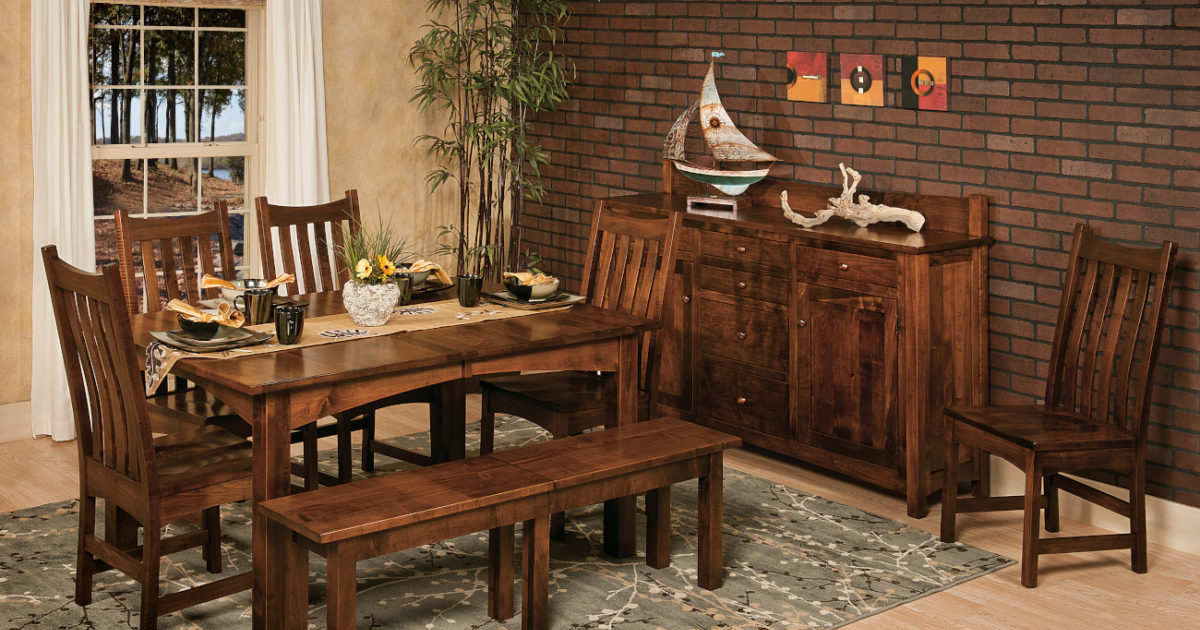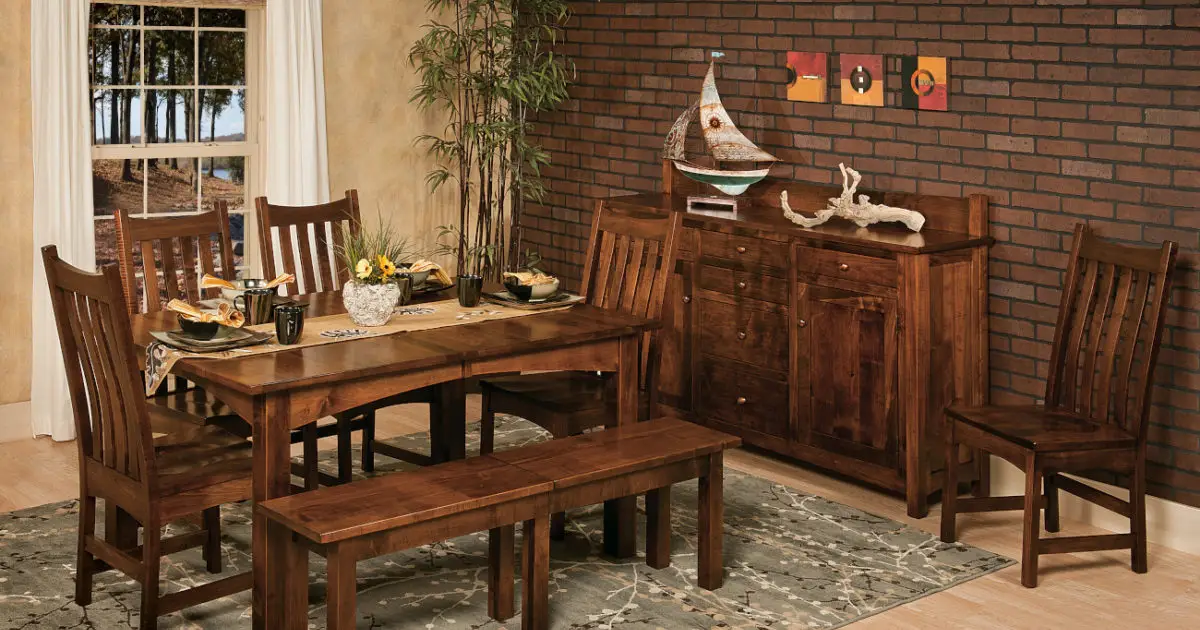
Have you ever gazed at an Amish furniture and thought, “Is this genuinely made by the Amish?” You’re certainly not the only one curious.
Yes, Amish furniture is genuinely crafted by the Amish. Authentic pieces feature durable construction methods, the use of solid hardwoods, a hand-applied finish, and a connection to specific regions, making them stand out in the market.
Join us as we explore the Amish craft’s fascinating history and modern practices, helping you recognize real Amish furniture and understand the genuine effort behind its creation.
Historical Background and Current Trends in Amish Furniture
Amish furniture started in America’s countryside and was made by a community famous for living simply and crafting skillfully.
At first, these pieces were made just for their usefulness, showing the Amish community’s focus on practical and long-lasting items.
Over time, Amish furniture became popular for more than just its function; people began to love it for its high quality and classic, enduring designs.
In the late 1800s, when factories changed how most things were made in America, Amish communities stuck to their traditions and made furniture by hand.
This approach differed significantly from the mass-produced furniture that was becoming popular elsewhere.
In the 1920s, when handmade folk art was celebrated, people outside the Amish communities started to notice and appreciate Amish furniture for its beauty and the excellent craftsmanship it showed.
Amish furniture has found its own special place in the furniture world today. While they continue to uphold their high standards of craftsmanship, some Amish artisans are now blending modern styles and what customers currently like into their designs.
This mix of traditional methods and modern looks has made Amish furniture more appealing to various people. These customers appreciate the craftsmanship and timeless designs and value sustainable and eco-friendly practices.
Many Amish furniture makers respond to this interest by using local materials, eco-friendly finishes, and making durable pieces. This approach matches the growing desire for responsible and sustainable consumer choices.
The Truth About Amish Furniture Making
Contrary to the belief that Amish furniture is plain and unsophisticated, Amish artisans embrace evolving styles and often incorporate varied design elements into their pieces, making each one distinct.
While there’s a common misconception that Amish furniture prioritizes simplicity over quality, the reality is quite the opposite. Amish craftsmanship is deeply rooted in a commitment to quality, with artisans focusing on durability and functionality, favoring meticulous craftsmanship over mass production. This approach not only reflects their dedication to quality but also their adherence to sustainability over convenience and short-term gain.

Furthermore, the traditional craftsmanship of Amish furniture is not as detached from modern technology as some might think. Amish workshops skillfully balance tradition with technology; they typically avoid using public grid electricity but employ diesel generators or pneumatic tools to enhance efficiency. This demonstrates a pragmatic blend of age-old methods and contemporary innovations.
Addressing another misconception, Amish furniture makers are not rigid in their techniques. Instead, they show remarkable flexibility in meeting customer demands. They uphold their traditional methods yet are adaptable, offering customization and responsiveness to consumer preferences.
This adaptability, coupled with their reputation for producing high-quality work, has enabled them to establish a strong and loyal customer base. Thus, the world of Amish furniture-making is one of dynamic traditions, blending the old with the new to meet modern needs while staying true to its roots.
If you’re curious, you might want to know more about the differences between Amish furniture and Chinese-made furniture.
Characteristics of Authentic Amish Furniture
Understanding Amish furniture means recognizing it as more than just functional and expensive furniture; it symbolizes quality and heritage.
Excellent Craftsmanship
Amish furniture uses time-honored techniques, reflecting a deep commitment to excellence and tradition. Each piece is handcrafted, meticulously carved, and precisely assembled.
Traditional methods like mortise-and-tenon joints and dovetailing ensure durability and enduring finishes, setting these pieces apart from typical flat-pack furniture.
To further highlight the Amish excellent craftsmanship, here’s a quick look at their most common and popular build techniques:

Durable and Aesthetic
The selection of materials is crucial. Hardwoods like oak, cherry, and maple are chosen for their durability, beauty, and timelessness.
Often locally sourced, this choice underscores the Amish commitment to sustainability and community support while showing respect for the natural beauty of the wood.
Simple Yet Elegant
Amish furniture is known for its simplicity and elegance, rooted in a tradition valuing functionality and minimalism.
The designs, free from ornate details, honor the raw beauty of the materials, resulting in timeless pieces that fit various interior styles.
Sustainable
Sustainability is central to Amish furniture-making. From local sourcing of materials to using natural or low-VOC finishes, the process is imbued with respect for the environment.
This approach to eco-friendly practices is part of a lifestyle prioritizing conservation and responsible stewardship, going beyond mere trends.
Timeless Design
Amish furniture’s simple and elegant design has a broad appeal, fitting effortlessly into various interior styles, from rustic to contemporary.
Untouched by fleeting trends, its design ensures that Amish furniture remains in style.
Cultural Connection
Purchasing Amish furniture is often viewed as connecting with and supporting a distinct cultural heritage. The craftsmanship in these pieces narrates the story of a community committed to its art, offering a part of Amish history and tradition.
Customization and Personalization
The ability to customize Amish furniture allows buyers to have pieces tailored to their preferences and needs. This flexibility enhances the furniture’s appeal and ensures each piece is as unique as its owner.
Identifying Authentic Amish Furniture
Knowing what differentiates it from imitations is essential to recognize genuine Amish furniture.
Construction Methods
A key indicator is the construction method. Authentic Amish furniture uses traditional joinery like dovetail or mortise-and-tenon joints instead of nails or staples.
These techniques make the furniture more durable and enhance its visual appeal, with precise and seamless joints indicating skilled handcrafting.
Type of Wood
The type of wood used is also telling. Genuine Amish furniture is crafted from solid hardwoods like oak, cherry, and maple, known for their longevity and beauty.
Any furniture claiming to be Amish-made but using materials like particleboard or veneers is likely inauthentic.
Finish
The finish on Amish furniture offers further clues. Genuine pieces usually have a hand-applied, smooth, and even finish that brings out the wood’s natural grain, unlike overly glossy or synthetic-looking finishes.
Origin
The origin of the furniture is crucial. Authentic Amish pieces are made by Amish communities, mainly in Ohio, Pennsylvania, and Indiana.
Pieces with unclear origins or linked to mass production facilities probably are not authentic.
Design
Lastly, the design and aesthetics are indicative. Amish Furniture is famed for its timeless, simple designs on functionality and durability.
Pieces with excessive decoration or modern elements that deviate from traditional Amish designs are likely not genuine.
Checklist: How Do You Know It’s Authentic?
It can be quite challenging to identify authentic Amish furniture if you’re not sure what to look for. Below is a checklist to help you identify what’s real and what’s not:

The Amish Furniture Market
The Amish furniture market is an intriguing mix of longstanding tradition and changing consumer trends, making a notable impact both within and outside Amish communities.
Small-scale Production and Quality
A vital aspect of the Amish Furniture market is its focus on small, family-run workshops instead of large factories. This decentralized approach guarantees the quality and authenticity of each piece, reflecting the Amish commitment to community and simplicity.
Channels of Distribution
Amish furniture reaches customers through various means. Some items are sold directly from workshops or local Amish stores. Others are available through online platforms and dealers specializing in Amish furniture.
This diversity in distribution has brought Amish furniture to a broader audience that values its craftsmanship and sustainable practices.
Diverse Demographics
The clientele for Amish furniture is varied, including those looking for durable, high-quality home furnishings, collectors of handcrafted items, and environmentally conscious consumers attracted to the sustainable practices and natural materials used in Amish furniture.
Adapting to Trends
The market is also evolving, with a growing demand for custom pieces that merge traditional Amish craftsmanship with contemporary designs.
This shift demonstrates Amish artisans’ adaptability and ability to meet modern consumer preferences without compromising their fundamental values of quality and tradition.
A Lifestyle Choice
Thus, the Amish furniture market represents more than just a commercial venture; it embodies a lifestyle choice for people who prioritize quality, sustainability, and the stories behind their furnishings.
If you’re interested in buying Amish furniture, you might want to read more on how to negotiate prices with Amish community.
Authenticity of Amish Craftsmanship
Authentic Amish furniture is much more than its renowned simplicity and sturdiness. It’s a reflection of a deep dedication to craftsmanship and cultural principles.
Each piece affirms its genuine Amish roots and narrates a tale of tradition, eco-friendliness, and adaptability in an ever-evolving world.
For those who buy and admire these timeless creations, it’s an engagement with a rich heritage that encapsulates the essence of being Amish in both craftsmanship and spirit.
